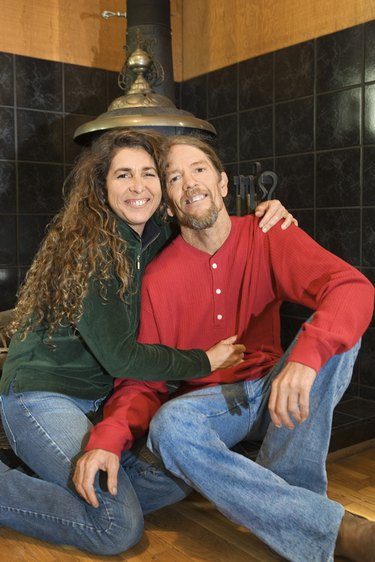Things You’ll Need
-
Cement backer board
-
Stud finder
-
4 inch drywall screws
-
1-inch nonconductive ceramic spacers
-
1-inch-high wooden blocks
-
Level
-
Drill
 A heat shield protects your wall from spontaneous combustion behind your stove. Image Credit: Jupiterimages/Comstock/Getty Images
A heat shield protects your wall from spontaneous combustion behind your stove. Image Credit: Jupiterimages/Comstock/Getty Images
Unless the manufacturer specifies otherwise, a wood-burning stove must be 36 inches from a combustible wall to be safe. To safely install a wood-burning stove closer to the wall, a noncombustible wall must be erected in front of the combustible wall as a heat shield, and a space must be left in between the heat shield and the wall itself. Many homeowners believe that a shield of stone, tile or brick over a combustible wall will provide adequate protection from heat, but this is inaccurate. Stone, tile and brick, while not combustible materials, still conduct heat from the air to the wall behind it. Over time, this can create a hazardous situation. Combustible materials consistently exposed to extreme heat may have a lowered ignition point.
Video of the Day
Step 1
Determine the placement of the wood-burning stove, then mark the area of the wall that must be protected with a noncombustible wall. Follow all clearance requirements provided by the manufacturer of your stove. Measure the height and width of your heat shield as marked on your wall, accounting for a 1-inch gap on the top, bottom and sides of the heat shield. Purchase fireproof cement backer board in these dimensions.
Step 2
Find the studs in the wall with a stud finder. Mark the placement of the studs on the combustible wall. Lean the cement backer board against the wall in the exact place where it will be installed, then mark the location of the studs on the cement backer board.
Step 3
Install 4-inch drywall screws every 12 inches along the stud lines you marked on the cement backer board. The tips of the screws should stick out the other side of the backer board by 1 1/2 inches.
Step 4
Place a row of 1-inch-high wood blocks on the floor in front of the wall where you will install the cement backer board.
Step 5
Ask a couple of friends to hold up the cement backer board. Place 1-inch nonconductive ceramic spacers over the tips of the screws protruding from the back of the backer board.
Step 6
Place the cement backer board on the row of blocks in front of the wall where the backer board will be installed, so the tips of the screws point directly into the wall and into the marks indicating where the studs are. Level the backer board with a level, and use a power drill to screw the backer board into the studs in the wall.
Step 7
Remove the wood block supports from beneath the wall.
Tip
You may leave the cement backer board as is or decorate it with ceramic tile.



























